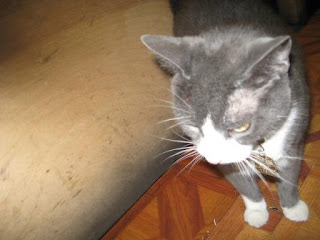This bike was parked on West 14th Street, near Sixth Avenue, in Manhattan:
It's a rather odd mishmash of bike design. On one hand, it's a traditional American women's frame with a swooped-down top tube. Another aspect of traditional American desgn is the mini-stay connecting the top tube with the down tube, which is also curvy in the manner of traditional American women's frames.
What I found interesting, though, is the top tube consists of twin parallel tubes, not unlike what we see on French-style mixte frames. And those tubes are welded together, as they were on lower-priced American bikes of the time, rather than lugged and brazed or filet-brazed.
This bike also has an Ashtabula (one-piece) crank, which was also typical of lower-priced American bikes of the time.
The bike is a Free Spirit, which was a line of bikes sold by Sears during the 1970's and early 1980's. Most of those bikes, as you might imagine, weren't the sort of things bought by high-mileage cyclists or entusiasts. Most of them, like the one in the photo, were made by one of the lower-end American manufacturers like Murray or Huffy, although there were a couple of "lightweight" models--including one with Reynolds 531 straight-gauge tubing in the main triangle--made in Austria by Steyr-Puch, the same company that made Puchs and Austro-Daimlers. Later Free Spirit bikes were made in Taiwan, before bikes from that country gained respect from dedicated cyclists.
They, and other sporting goods sold by Sears, were endorsed by none other than Ted Williams. He was a great player, but somehow I don't think of him as a free spirit. (I never saw him play, as he was a bit before my time. However, he has my respect because, in his Hall of Fame induction speech, he advocated for the induction of Negro League players, none of whom were enshrined in the Hall at that time.)
I'm sorry I couldn't take a better photo. I was squirreling in between the few inches (I ain't as skinny as I used to be!) between the bike and the scaffold for a building that's under removation. So I couldn't get into a much better position to take a photo. Also, I used my cell phone, as I didn't have my camera with me. I had gone to my doctor, who monitored the healing of the conjunctivitis I came down with, and I wasn't riding or thinking much about photography.
The bike looks as if it was ridden once or twice after it was purchased, then it was holed up in a garage or basement before its current owner found it in a thrift shop or garage sale. Although it's a bike I wouldn't buy for myself, I'm glad it's getting use, And, even though I never liked the paint jobs on this or any other Free Spirit, I think this one is kinda cute, if in a tongue-in-cheek sort of way, with that basket on the front.























